
St Sidwells and Sidwell Street - a short history
Also see:
Memories
of St Sidwell's by Mr Aggett
Memories
of the St Sidwell blitz
Although outside the city wall, St Sidwells and Sidwell Street which runs through the middle, is an important area in the development of Exeter, as the street was part of the ancient trackway between Stoke Hill and the High Street. This was the easiest route into the city for heavily laden carts from the north east, as routes from other directions crossed steep valleys or had sharp gradients. William the Conqueror, and Henry VII were both welcomed (or not) through the Eastgate, at the head of Sidwell Street.
Dwellings, shops and inns were built along the street, although a traveller leaving Exeter would have been in the countryside within a couple of hundred meters or so. Behind the buildings were small yards and fields sloping down to the Shytebrook at the bottom of Paris Street or the Longbrook on the northern side. St Sidwell's Church was essentially a country outpost to the mother church of St Michael's in Heavitree.
As Sidwell Street led directly to the Eastgate, it sometimes became the centre of disturbances. During the Prayer Book rebellion of 1549, Catholic rebels, many from Cornwall laid siege to Exeter. They captured St Sidwell's Church and held prisoners in the tower, including Sir Walter Raleigh's father, who had been perceived as an enemy, for admonishing a woman for having a rosary.
The civil war put a temporary stop to the development of Sidwell Street when the Royalist defenders ordered all buildings outside the Eastgate to be demolished as far as St Anne's Chapel, to give a clear field of fire. In addition, large earthworks were constructed outside the Eastgate as part of the defences. After the civil war, rebuilding commenced, although, development didn't much go beyond the junction with Old Tiverton Road and the Bath Road (now Blackboy Road) until the 19th century.
Richard Izacke in his Antiquities of the City of Exeter wrote that in 1673:
'St Sydwels street paved to St Anns Chappell from ye Eastgate [by ye Dean & Chapter of this Church being lords of ye said Mannor.]'
Apart from Cathedral Yard, the city within the walls was governed by the Mayor and Chamber. The parish of St Sidwell's, as a satellite of Heavitree, was largely owned by the church and many premises were leased from the Dean and Chapter; shops on the corner of Paris Street and between the churchyard and Debenhams are still owned by the Church Commissioners. This situation often resulted in disputes between the City and the Chapter, when the Chamber would attempt to fine a citizen in Sidwell Street for unlawful trading, or some other misdemenour, and the Chapter would take exception.
Victorian Sidwell Street
During the first forty years of the nineteenth century, Exeter expanded quickly - the population of St Sidwell's increased from 2,700 in 1801 to 6,600 in 1831. By 1844, urban development stretched from Eastgate, along Sidwell Street and Blackboy Road as far as Workhouse Lane, now Polsloe Road. To facilitate the newly introduced horse trams in 1882, the road was paved with wooden blocks to make it easier on the hooves of the horses. Both horse-drawn and, from 1905, electric trams ran along the street as far as Mount Pleasant and later St Marks Church until 1931.
During the nineteenth century, many terraces and small courtyards were built behind the shops of Sidwell Street. The inhabitants off Sidwell Street suffered almost as much deprivation as some in the West Quarter. Verney Place, Red Lion Court, Jeffery's Row, Forresters Court and others stretching to Newtown provided overcrowded and insanitary accommodation for working families.
Probably due to its large working population, and also its position on the road to Bath, Sidwell Street has probably had more inns and public houses than any other part of Exeter. The oldest was the Bude Hotel that started life back in 1358 as the Londonsyn, owned by the Courtenays. Also see Historic Pubs of Sidwell Street
Twentieth Century
As mentioned the electric tram reached Sidwell Street in 1905, but it was the motor car that dominated the street up until the Second World War. The street became the centre for the garage trade, and by 1923 Standfield & White, Motor Mac's, Yeo & Davey, Maude's Motor Mart, Eveleigh's Garage and Cox Bros lined the street, providing new car sales, repairs and petrol for those lucky enough to be able to afford them.
Although motoring was enthusiastically embraced in the first half of the 20th Century, it was still the pursuit of the wealthy. This is indicated by the 1923 street directory that lists the Exeter Cycling Club in its Golden Jubilee Year, Mrs Kate Matthews cycle dealer, and the Halford Cycle Co, which was in almost exactly the same place that it is today. For the working man it was the bicycle and the tram.
The blitz
The bombing of 1942 devastated Sidwell Street and a huge area to the south. The firewatch reported that petrol in the Wessex Garage caught alight, and the fire spread to Standfield and White, then on to MacFisheries and Dunsford - all were completely destroyed. Elsewhere, Cox Garage was quickly alight and the flames spread down Sidwell Street, while Motor Mac was saved from destruction by Mr Forgham, manager of the Savoy Cinema who borrowed a hose and played water over the fire until the National Fire Service arrived.
Mr Aggett gave this account of one bomb in St Sidwell's for People Talking:
"You know St Sidwell's Avenue, flanking St Sidwell's School: a heavy bomb - I should think it was a 4,000, to 6,000 pound bomb - pitched exactly in the middle of that avenue. I went down there a few minutes after the bomb had pitched, You know when children play with cards they stack them all up and then they touch one and they all go down, well, that blast was so terrific that all the houses had gone down like that, right down to the bottom of the Avenue each side. You could see them with their bay windows still intact in a sense but all leaning down. There was a terrific crater there in the centre of the road."
Records show that it was actually a 500 lb bomb described by Mr Aggett - what he didn't recall was the seventeen dead from the blast.
After the war, some businesses, such as Standfield and White continued to trade from their bombsites, before rebuilding commenced.
The rebuilding in the 1950's and 60's resulted in the usual bland brick and concrete boxes that appeared all over Exeter. The last of the old shops at the city end of Sidwell Street were demolished in the late 1960's and replaced with Tescos, a new office for Force and Sons, Edna Sherrill the florist and the later tenants of Iceland. Force and Son have had an office, almost at pricisely the same site since 1790. Bobbys on the corner of Sidwell Street and New North Road built the tower block that became Debenhams, and was promptly voted into the Sunday Times ten ugliest buildings in the country. The Express and Echo relocated from the High Street, printing press and all, into what is now the Safeway Supermarket, in 1958. Rationalisation in the 1990's by the parent group moved the newspaper out of the city for the first time to Sowton Industrial Estate.
The top end of the street retains some buildings from the late 19th century, and show a little of what Sidwell Street looked like before the war. The Sidwell Street Methodist Church was opened in May 1905, using an innovative method of construction. The Odeon Cinema opened in 1939, escaped the bombing of 1942, providing Exonians and visiting servicemen with much needed entertainment at that time.
The wide pavement on the southern side of Sidwell Street gives enough room for small, independent traders to set up their stalls, and from time to time, there is a French or German market in the street. After the redevelopment of Princesshay, the City Council are planning to refurbish and rebuild the area including Sidwell Street in what they term, the Grecian Quarter. The old Debenhams is to be refurbished, while there are plans to attract more national retailers such as the John Lewis Group into a new store on the bus station site.
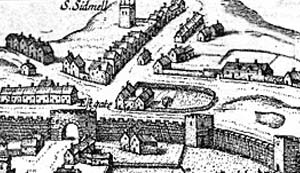 Sidwell Street in
1617
Sidwell Street in
1617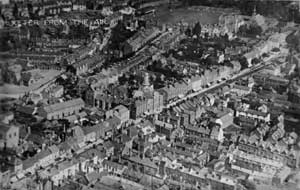 Sidwell Street from
the air - early 1930's.
Sidwell Street from
the air - early 1930's.
- Frederick Henry Willey was born in Sidwell Street in 1830. His father was a cordwainer or shoemaker.
- On Whit Mondays, there used to be races between the Victory Inn and the Temeraire (Horse and Dray) in Blackboy Road.
- Farmers used to drive flocks of sheep up the top end of Sidwell Street, while a marooned tram would crawl through a sea of wool.
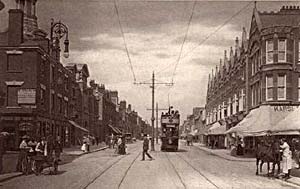 The
Edwardian, top end of Sidwell Street.
The
Edwardian, top end of Sidwell Street.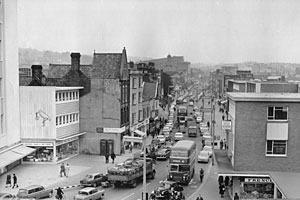 View towards the
north east in 1966.
View towards the
north east in 1966.
Courtesy the City Parks Department
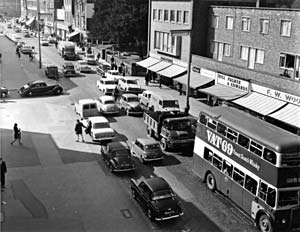 Looking towards
the city in 1966.
Looking towards
the city in 1966.
Courtesy the City Parks Department
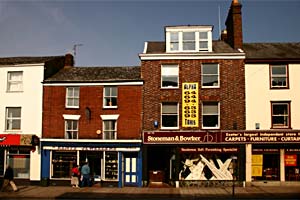 Shops
near the Odeon.
Shops
near the Odeon.
Some Sidwell Street Pubs
Amber Rooms
Bude Hotel / Old London Inn
Duke of York
Historic Pubs of Sidwell Street
│ Top of Page │